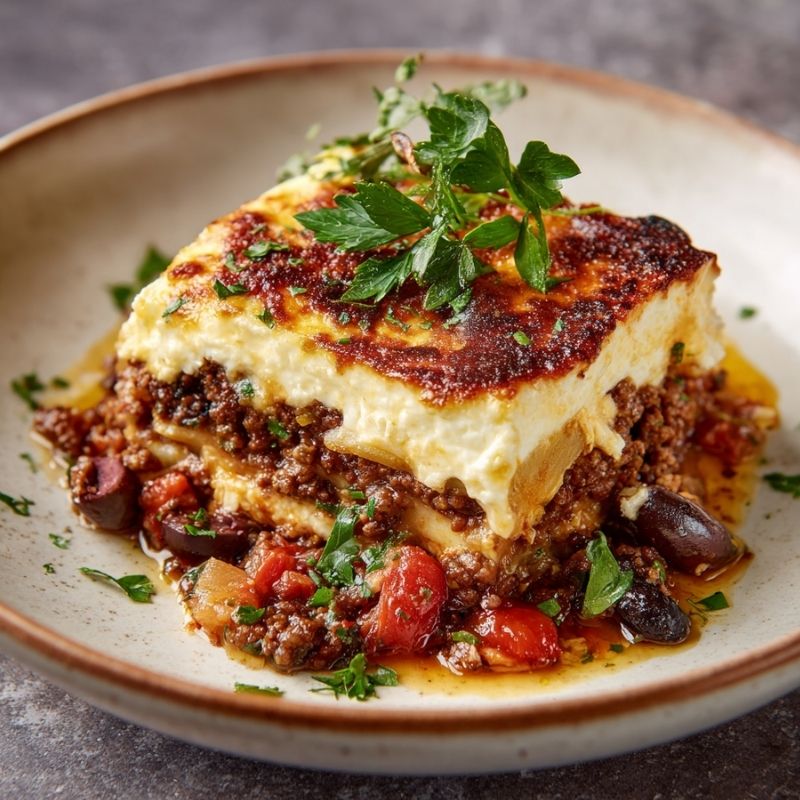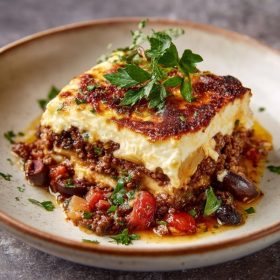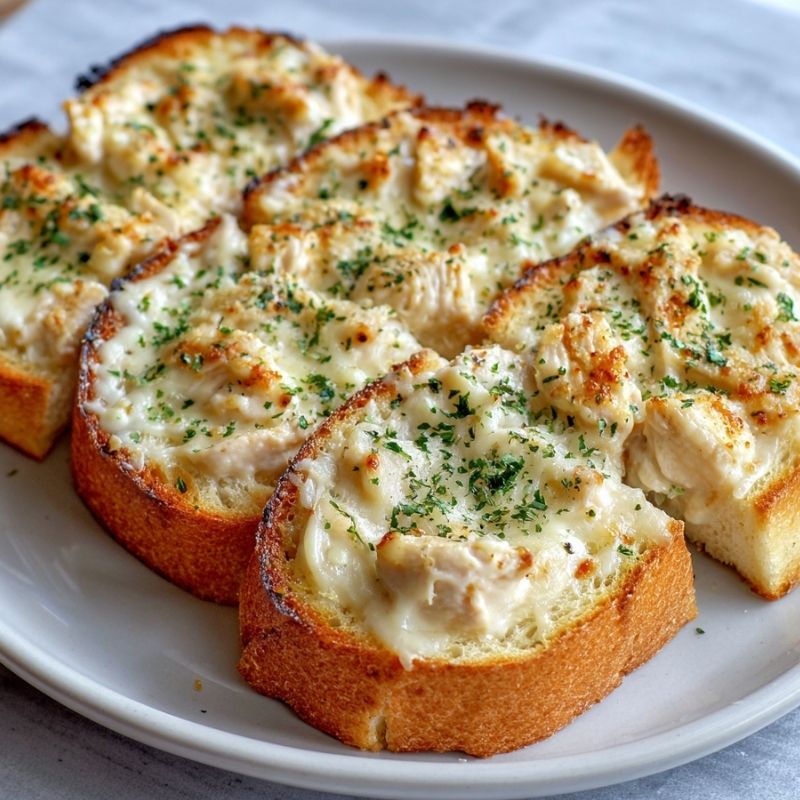One Sunday afternoon, my daughter invited the whole family over for a “Greek night.” Each of us was asked to bring something inspired by Mediterranean cooking. I wanted to make something hearty enough to feed a crowd and elegant enough to remind everyone of a feast.
Moussaka instantly came to mind. I remembered a small taverna my husband and I visited years ago on a trip to Athens. The memory of those rich layers of vegetables, spiced meat sauce, and creamy topping never left me, so this seemed like the perfect chance to bring that flavor home.
Cooking it filled the house with aromas of cinnamon, garlic, and simmering tomatoes that had everyone wandering into the kitchen to peek at what was bubbling away. I worked in layers, almost like piecing together a story—potatoes for the foundation, eggplants for depth, zucchini for freshness, and that luscious bechamel to crown it all. As it baked, the golden crust formed, and I could hear laughter drifting from the living room, reminding me why I love making dishes like this.
When we finally sat down to eat, the first slice was met with a silence that only happens when people are too busy savoring. Then came the smiles, the requests for seconds, and the knowing look from my husband that said, “You nailed it.” Moments like these are why I still treasure long, layered recipes like Moussaka—they aren’t just meals, they’re gatherings on a plate.

Short Description
Greek Moussaka is a layered casserole of fried vegetables, spiced meat sauce, and a creamy bechamel topping, baked until golden brown. Comforting, rich, and deeply flavorful, it’s a dish that celebrates Mediterranean cooking at its finest.
Key Ingredients
For the Vegetable Base
- 2 cups olive oil (for frying, amount may vary)
- 4 potatoes
- 4 zucchini
- 4 eggplants
- 200 g Kefalograviera cheese, finely shredded (or parmesan, kasseri, pecorino)
- 1 tablespoon salt
- ½ tablespoon pepper
For the Meat Sauce
- 2 tablespoon olive oil
- 1 large red onion, finely chopped
- 1 medium garlic bulb, minced
- 1 kg beef mince
- 1 cup red wine
- 800 g crushed canned tomatoes
- 1 tablespoon salt
- ½ teaspoon white pepper
- ½ teaspoon ground cinnamon
- ½ teaspoon ground nutmeg
- 2 teaspoon sugar
- ½ teaspoon thyme
- 1 teaspoon oregano
- 3 bay leaves
- 1 bunch parsley, finely chopped
For the Bechamel
- 150 g unsalted butter
- 1 cup plain flour
- 1 litre milk
- 2 egg yolks
- ½ teaspoon nutmeg
- 250 g Kefalograviera cheese, finely shredded
Tools Needed
- Large skillet or frying pan
- Large pot
- Medium saucepan
- Wooden spoon
- Whisk
- Baking dish (large, deep)
- Paper towels or wire rack
Cooking Instructions
Step 1: Prepare the Vegetables
Slice potatoes, zucchini, and eggplants into even disks. Heat olive oil in a skillet over medium-high and fry until golden brown. Drain on paper towels or a wire rack to remove excess oil.
Step 2: Cook the Meat Sauce
In a pot, heat olive oil. Add onion and garlic; cook until soft and fragrant. Stir in beef mince, breaking it up until browned. Pour in red wine and simmer until reduced.
Add tomatoes, salt, white pepper, cinnamon, nutmeg, sugar, thyme, oregano, bay leaves, and parsley. Simmer 10 minutes until thickened. Remove from heat and discard bay leaves.
Step 3: Make the Bechamel
In a saucepan, melt butter over medium heat. Stir in flour to make a smooth paste. Gradually whisk in milk until creamy. Stir constantly to avoid lumps. Remove from heat and whisk in egg yolks, nutmeg, and shredded cheese. Set aside.
Step 4: Assemble the Moussaka
Preheat oven to 165°C (fan-forced). In a baking dish, layer potatoes on the bottom, season, and sprinkle with cheese. Add eggplants, season, and sprinkle with cheese. Layer zucchini, season, and sprinkle with cheese. Add another layer of eggplant with remaining cheese. Spread meat sauce evenly over vegetables. Finish with bechamel sauce, spreading it smooth.
Step 5: Bake
Bake uncovered for 40 minutes, checking after 30, until top is golden brown and bubbling. Let rest for at least 30 minutes before slicing—this helps the layers set beautifully.
Why You’ll Love This Recipe
Rich Layers: Every bite combines tender vegetables, savory meat, and creamy bechamel.
Comfort Food at Its Best: Warm, filling, and perfect for sharing with loved ones.
Authentic Flavors: Spices like cinnamon and nutmeg add depth that’s distinctively Greek.
Make-Ahead Friendly: Can be prepared ahead and baked when ready.
Crowd-Pleaser: Ideal for gatherings, holidays, or a hearty family dinner.
Mistakes to Avoid & Solutions
Over-oiling the vegetables: Drain on paper towels or use a wire rack to keep the dish from turning greasy.
Lumpy bechamel: Whisk constantly while adding milk. If lumps form, strain the sauce before adding cheese.
Undercooked vegetables: Fry until tender before layering; raw vegetables will release water and make the dish soggy.
Cutting too soon: Rest at least 30 minutes, or the layers will collapse when sliced.
Using too little seasoning: Each vegetable layer should be lightly seasoned to avoid a bland result.
Serving and Pairing Suggestions
Serve as a main course with a simple green salad.
Pair with fresh bread or pita to soak up the sauce.
For drinks, enjoy with red wine or a chilled sparkling water with lemon.
Perfect for family-style dining or as part of a Mediterranean buffet.
Storage and Reheating Tips
Store leftovers in an airtight container in the fridge for up to 3 days.
Reheat in the oven at 160°C until warmed through to keep the top crispy.
Freeze portions tightly wrapped in foil for up to 2 months; thaw overnight in the fridge before reheating.
FAQs
1. Can I use lamb instead of beef?
Yes, lamb is traditional in many Greek households and adds a deeper flavor.
2. Do I have to fry the vegetables?
No, you can roast them with a light brush of olive oil for a lighter version.
3. Can I prepare it ahead of time?
Absolutely. Assemble up to a day before, refrigerate, then bake when ready.
4. What’s the best cheese substitute if I can’t find Kefalograviera?
Parmesan, kasseri, or pecorino all work well.
5. Why does my bechamel separate?
Overheating can cause curdling. Keep the heat moderate and stir constantly.
Tips & Tricks
Use a mandoline for evenly sliced vegetables.
Add a pinch of cinnamon to the bechamel for extra warmth.
Roast instead of fry if you want less oil.
Make in smaller ramekins for individual servings.
Always let it rest before cutting—patience pays off.
Recipe Variations
Vegetarian Moussaka: Replace meat with lentils or mushrooms; follow the same sauce steps.
Lighter Version: Roast veggies instead of frying and use low-fat milk for the bechamel.
Cheesy Twist: Add a layer of feta between vegetables for extra creaminess.
Spicy Moussaka: Add chili flakes to the meat sauce for a little heat.
Mini Moussaka Cups: Layer ingredients in muffin tins for individual servings.
Final Thoughts
Making Greek Moussaka always feels like a labor of love, but when it comes bubbling out of the oven, it proves itself worth every step. The way the spices linger in the air while it bakes is enough to set the mood for the meal. When my family gathered around the table that evening, plates filled and laughter flowing, I couldn’t help but feel grateful for recipes like this—ones that bring people together. The golden topping cracked perfectly as I cut into it, each portion revealing its colorful layers.
Watching everyone dive in, passing plates for seconds, and even sneaking bites straight from the dish once dinner ended was a joy. Moussaka is more than food; it’s a celebration of patience, tradition, and sharing. It left us full, not just in stomach but in spirit, and that, to me, is the best kind of recipe.

Greek Moussaka
Ingredients
For the Vegetable Base
- 2 cups olive oil for frying, amount may vary
- 4 potatoes
- 4 zucchini
- 4 eggplants
- 200 g Kefalograviera cheese finely shredded (or parmesan, kasseri, pecorino)
- 1 tablespoon salt
- ½ tablespoon pepper
For the Meat Sauce
- 2 tablespoon olive oil
- 1 large red onion finely chopped
- 1 medium garlic bulb minced
- 1 kg beef mince
- 1 cup red wine
- 800 g crushed canned tomatoes
- 1 tablespoon salt
- ½ teaspoon white pepper
- ½ teaspoon ground cinnamon
- ½ teaspoon ground nutmeg
- 2 teaspoon sugar
- ½ teaspoon thyme
- 1 teaspoon oregano
- 3 bay leaves
- 1 bunch parsley finely chopped
For the Bechamel
- 150 g unsalted butter
- 1 cup plain flour
- 1 litre milk
- 2 egg yolks
- ½ teaspoon nutmeg
- 250 g Kefalograviera cheese finely shredded
Instructions
- Slice potatoes, zucchini, and eggplants into even disks. Fry in olive oil over medium-high heat until golden, then drain on paper towels or a wire rack.
- In a pot, heat olive oil and sauté onion and garlic until soft. Add beef mince, breaking it up until browned. Pour in red wine and simmer until reduced.
- Stir in tomatoes, salt, white pepper, cinnamon, nutmeg, sugar, thyme, oregano, bay leaves, and parsley. Simmer 10 minutes until thickened, then remove bay leaves.
- For the bechamel, melt butter in a saucepan. Stir in flour to form a paste, then gradually whisk in milk until creamy, stirring constantly to prevent lumps. Remove from heat and whisk in egg yolks, nutmeg, and cheese.
- Preheat oven to 165°C (fan-forced). In a baking dish, layer potatoes on the bottom, season, and sprinkle with cheese. Add eggplants, then zucchini, seasoning and sprinkling with cheese between each layer.
- Add another layer of eggplant with remaining cheese. Spread meat sauce evenly, then finish with bechamel, smoothing the top.
- Bake uncovered for 40 minutes, checking after 30, until golden brown and bubbling. Let rest at least 30 minutes before slicing to set the layers.


